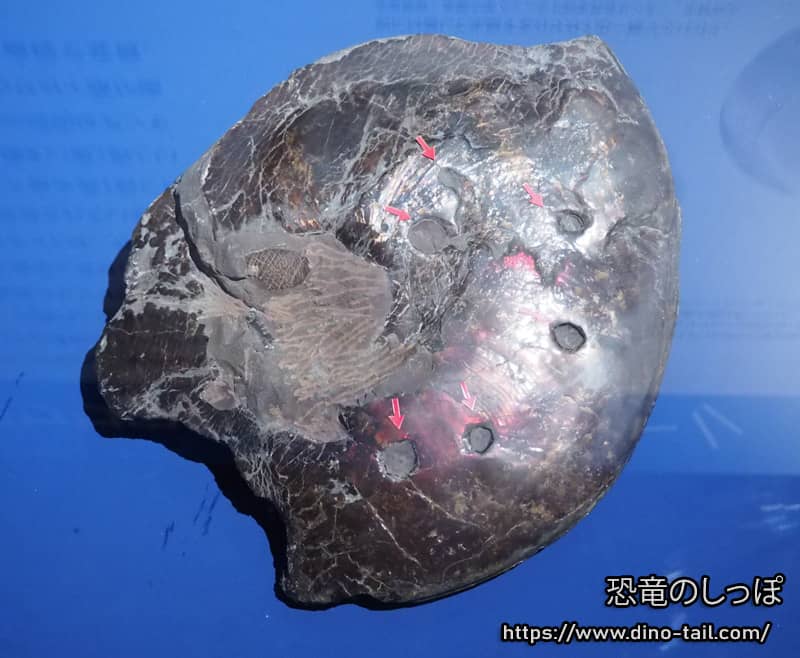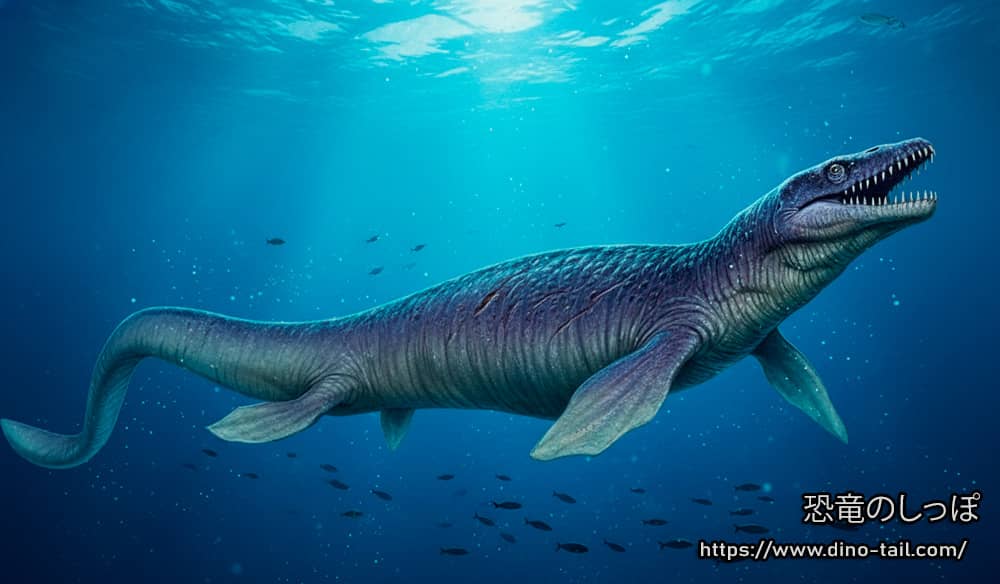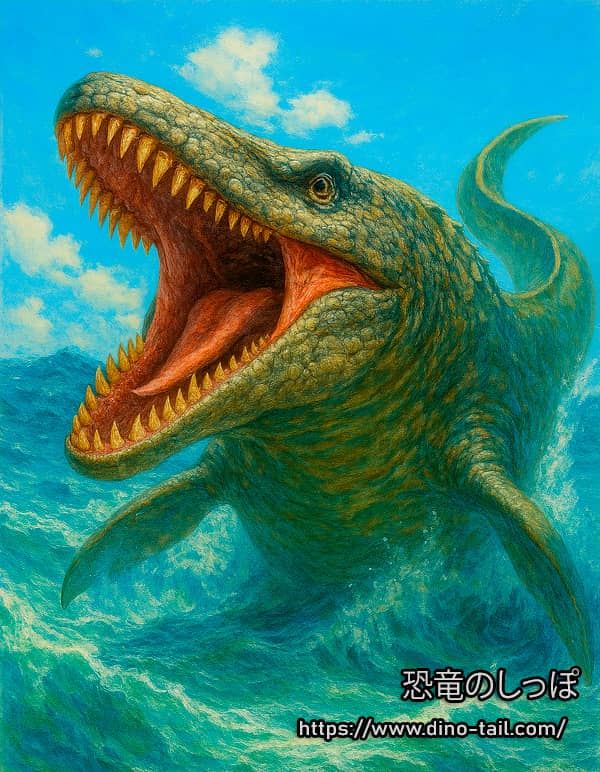Mosasaurus Basic Data
| Scientific Name (Genus) | Mosasaurus |
|---|---|
| Name Meaning | Meuse River lizard |
| Classification | Squamata, Mosasauridae |
| Total Length | Up to approx. 17m (M. hoffmannii) |
| Diet | Carnivore (fish, ammonites, other marine reptiles, etc.) |
| Period | Late Cretaceous (approx. 70-66 million years ago) |
| Discovery Location | Netherlands, North America, Africa, Antarctica, etc. (worldwide) |
| Year Described | 1822 |
Characteristics: Apex Predator of the Cretaceous Seas
Mosasaurus was a giant marine reptile that reigned in the seas of the Late Cretaceous period. It stood at the top of the marine ecosystem of its time.
Importantly, Mosasaurus was not a "dinosaur." Scientifically, "dinosaur" refers to a specific group of reptiles with distinct skeletal features that walked upright on land. Mosasaurus was a reptile that spent its entire life in the sea.
Taxonomically, it belongs to the order Squamata, which includes modern lizards and snakes. Its body was highly adapted for marine life, featuring a streamlined torso, limbs evolved into flippers, and a powerful, shark-like bilobed tail fin.
Flexible Jaws

The most formidable feature of the Mosasaurus's jaw was its flexibility. There was a joint midway along the lower jawbone, allowing it to open its mouth incredibly wide, similar to snakes. This "double-jointed" structure is thought to have enabled it to swallow prey even larger than itself whole. This is a characteristic shared with its terrestrial relatives, snakes, and serves as strong evidence of Mosasaurus's affinity with lizards.
Powerful Propulsion
The primary propulsion for swimming came from its powerful tail. It was once imagined to swim by undulating its entire body like sea snakes or crocodiles. However, this image was overturned by the discovery of exceptionally well-preserved specimens of related species like Platecarpus, which included skin impressions. These fossils suggest that mosasaurs possessed large, crescent-shaped tail flukes at the tip of their tails, similar to sharks and ichthyosaurs. By powerfully swinging this tail fin side to side, they likely generated acceleration to pursue prey.
Pharyngeal Jaws: The Second Jaw

One of the most distinctive features of Mosasaurus was its jaw structure. In addition to powerful main jaws lined with sharp, conical teeth, it possessed another set of jaws deep in its throat: the "pharyngeal jaws."
These pharyngeal jaws also had teeth and are thought to have functioned like a conveyor belt, gripping captured prey and pulling it further down the throat. This mechanism allowed Mosasaurus to securely swallow even large prey such as fish, ammonites, other marine reptiles, and smaller mosasaurs.
Excellent Vision and Smell
Mosasaurus was a hunter with keen senses. Fossils show that its eye sockets were very large, suggesting excellent vision for spotting prey. Furthermore, the structure of its skull indicates the likely presence of a Jacobson's organ, a specialized chemosensory organ found in modern snakes and lizards. They might have flicked their forked tongues in and out underwater, like snakes, analyzing scent particles with this organ to track prey by smell or identify mates.
Extinction of Mosasaurus
The factors leading to the extinction of Mosasaurus were complexly intertwined. The direct impact of the asteroid collision, causing massive tsunamis and shockwaves, would have inflicted immense damage. However, the more decisive factor was the subsequent global environmental devastation.
Vast amounts of dust and soot ejected by the impact shrouded the upper atmosphere, blocking sunlight for an extended period. With sunlight unable to reach the surface, phytoplankton, the base of the marine ecosystem, could not photosynthesize and died off on a massive scale.
This caused the foundation of the food web to collapse. Zooplankton that fed on phytoplankton decreased, followed by the small fish and ammonites that ate them, and the chain reaction of starvation rapidly spread up the ecosystem to larger organisms.
Ironically, the very characteristics that made Mosasaurus the ruler of the seas became its fatal weaknesses in this crisis. Maintaining its enormous body required a vast amount of food constantly. It was too specialized as an apex predator. The collapse of the food web dealt the most severe blow to the top predators requiring the most energy. Deprived of its prey, Mosasaurus was dragged from its throne of dominance and driven to extinction. Its very success became the cause of its demise.
Furthermore, sulfur oxides released into the atmosphere by the impact are thought to have caused massive acid rain, rapidly degrading the chemical properties of the oceans, delivering a further blow to many marine organisms.
Thus, the reign of the mosasaurs, which had lasted for about 30 million years, came to an abrupt end in a geological instant.
Discovery of Mosasaurus
The first scientifically documented Mosasaurus fossil was a fragment of a skull discovered in 1764 in a limestone quarry on Saint Peter's Mountain near Maastricht, a city in the southern Netherlands. The bones of this unknown creature greatly puzzled scientists of the time. Initially thought to belong to a giant fish, a more complete skull found in 1780 was even misidentified as belonging to a crocodile. Records also show that another researcher considered it a type of whale.
Research continued, and in 1822, the English paleontologist William Daniel Conybeare concluded that the creature was a member of an extinct group of giant lizards. He named it Mosasaurus ("Meuse River lizard") after the river near its discovery site.
Mosasaurus thrived in the seas during the very end of the Cretaceous period, just before the extinction of the dinosaurs. However, it disappeared along with the dinosaurs and ammonites during the mass extinction event about 66 million years ago.
Mosasaurus: Science vs. Fiction

Scientifically, it's believed to have been covered in smooth scales. Daily jumping behavior is considered unlikely.
Sixty-six million years after its extinction, Mosasaurus reappeared before us as fossils, and then gained unprecedented fame in modern pop culture. Its prominent role in the 'Jurassic World' movie series, in particular, propelled this ancient marine reptile to global stardom. However, its portrayal blends scientific fact with fiction, and comparing the two reveals interesting aspects of science communication.
The depiction of Mosasaurus in the movies includes several embellishments for maximum entertainment value, differing from scientific knowledge in several ways:
- Exaggerated Size : The Mosasaurus in the movies is depicted as a true "kaiju" or "monster," reaching lengths of 30 meters or more. However, as mentioned earlier, the maximum length of the real Mosasaurus is scientifically estimated to be around 12-18 meters, making the movie portrayal significantly exaggerated.
- Differences in Appearance : The movie Mosasaurus has a rugged, crocodile-like back, but there is no fossil evidence that the actual Mosasaurus skin was like this. Instead, fossils of related species suggest it was covered in smooth scales. Also, the tail shape is depicted more simply, rather than the scientifically favored shark-like bilobed fluke.
- Behavioral Dramatization : The behavior of leaping high out of the water vertically to catch prey is purely for the dramatic effect of a theme park show. While modern whales and dolphins do jump, it's unlikely that Mosasaurus routinely hunted in this manner.
While it's easy to point out these scientific inaccuracies, the power of fiction cannot be ignored. The Mosasaurus of 'Jurassic World', though scientifically inaccurate, etched the name "Mosasaurus" into the minds of people worldwide through its spectacular presentation.
